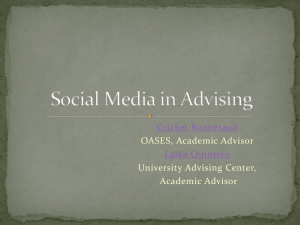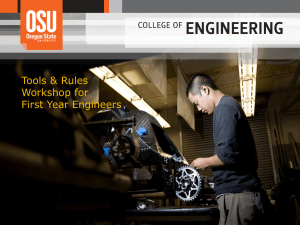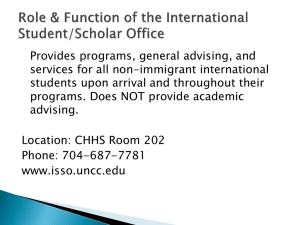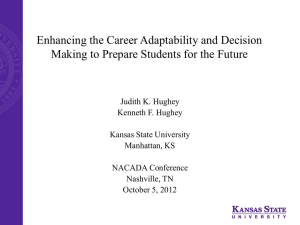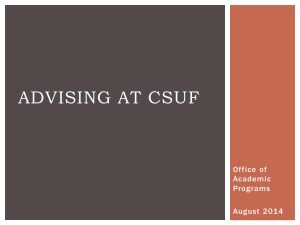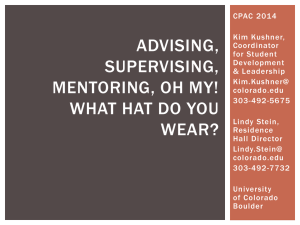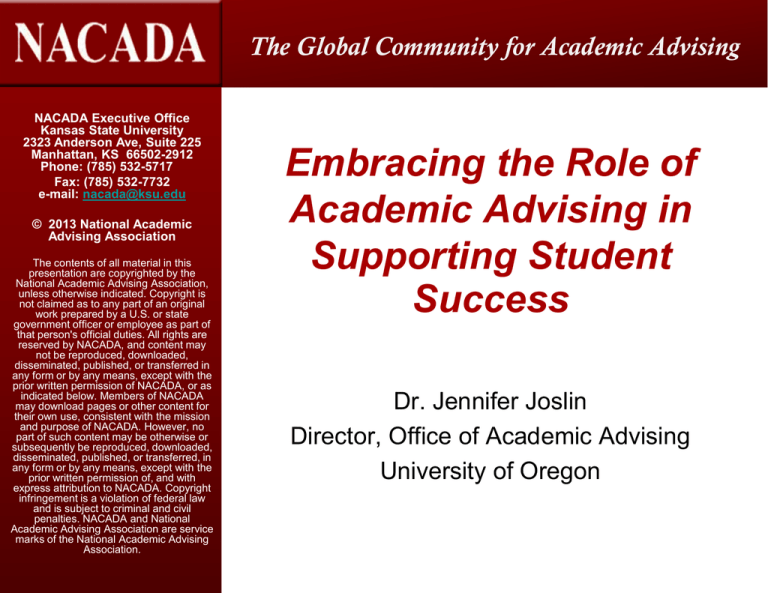
The Global Community for Academic Advising
NACADA Executive Office
Kansas State University
2323 Anderson Ave, Suite 225
Manhattan, KS 66502-2912
Phone: (785) 532-5717
Fax: (785) 532-7732
e-mail: nacada@ksu.edu
© 2013 National Academic
Advising Association
The contents of all material in this
presentation are copyrighted by the
National Academic Advising Association,
unless otherwise indicated. Copyright is
not claimed as to any part of an original
work prepared by a U.S. or state
government officer or employee as part of
that person's official duties. All rights are
reserved by NACADA, and content may
not be reproduced, downloaded,
disseminated, published, or transferred in
any form or by any means, except with the
prior written permission of NACADA, or as
indicated below. Members of NACADA
may download pages or other content for
their own use, consistent with the mission
and purpose of NACADA. However, no
part of such content may be otherwise or
subsequently be reproduced, downloaded,
disseminated, published, or transferred, in
any form or by any means, except with the
prior written permission of, and with
express attribution to NACADA. Copyright
infringement is a violation of federal law
and is subject to criminal and civil
penalties. NACADA and National
Academic Advising Association are service
marks of the National Academic Advising
Association.
Embracing the Role of
Academic Advising in
Supporting Student
Success
Dr. Jennifer Joslin
Director, Office of Academic Advising
University of Oregon
Retention by the Numbers
Students who completed their degrees at
the same institution within 5 years
NCES 1995-96 Cohort
NCES 2002 Cohort
Berkner et. al., 2002
Retention by the Numbers
Students who completed their degrees at
the same institution within 5 years
51%
NCES 1995-96 Cohort
52.3%
NCES 2002 Cohort
Berkner et. al., 2002
Topics
1. Political and Economic Pressure
2. Academic Advising and Retention
3. Engagement and the College Experience
4. Promising Philosophical Perspectives &
Practices
5. Questions for Contemplation and Discussion
1. Political and Economic Pressure
Today’s Headlines
Student Retention and Persistence is a
hot topic for Higher Education institutions
because of:
•
•
•
•
•
Public Perception
Changing Workplace
Government Interests
Resource/Revenue Generation
Global Financial Crisis
Headlines
May 30, 2008
December 21, 2012
Colleges Mine Data to Predict
Dropouts
We need to produce learners,
not just students
By Catherine Rampell
By Robert Talbert
October 12, 2012
January 3, 2013
College Education Is Expected to
Remain a High Priority for States
By Eric Kelderman
College Persistence Linked to
Rigorous Courses and Academic
Advising
By Caralee Adams
October 14, 2012
November 29, 2012
Community Colleges for the
Students They Actually Have
Admissions Report Reflects a
Decade of ‘Unparalleled
Uncertainty’
By Josh Wyner
By Eric Hoover
Textile
Winding
Setter
40%
reduction in
jobs between
2008-2018
Martha Cooper, photographer
Library of Congress
Carnevale, et. al., 2010
IT & health
professionals,
2008-2018:
Computer software
engineers:
34% growth
Home health aides:
50% growth
Network analysts:
53% growth
Carnevale, et. al., 2010
Nimataradji, photographer
66% of jobs in the United
States will require a
postsecondary education
& training by 2020
51% of all jobs in
Arkansas will require a
postsecondary education
& training by 2020
Carnevale & Smith, 2012
Unemployment based on education,
2011
Bureau of Labor Statistics
What Does this Mean for Academic Advising
and Advising Administrators?
Not because I can email a Rihanna song
from my phone.
RT @ftrain @suzisteffen
2. Academic Advising and Retention
Our Shared Goal: Student Success
“Retention is a byproduct of a
good educational experience.”
Vincent Tinto
Leaving College: Rethinking the Causes
and Cures of Student Attrition, 1993
Academic Advising is Essential
“Effective retention programs have
come to understand that academic
advising is at the very core of
successful institutional efforts to
educate and retain students.”
Vincent Tinto
Leaving College: Rethinking the Causes
and Cures of Student Attrition, 1993
Key Institutional Conditions
High Expectations
Support
Academic Advising
Involvement
Student-Learning Focused
Vincent Tinto, 2007
Taking Student Retention Seriously
Key Institutional Conditions
Klepfer & Hull longitudinal study of over
9,000 high school sophomores through
2nd yr in college discovered 3 factors
related to student success:
High-level Mathematics
AP/IB Courses
Academic Advising
Center for Public Education at the National School Boards Association
Kasey Klepfer & Jim Hull, 2012, as reported by Adams
http://bit.ly/RxoqxX
Advising Serves as a Bridge
“Personal tutoring [academic advising]
can provide information about higher
education processes, procedures and
expectations….Personal tutoring can
provide guidance and structure,
especially in those early days.”
Liz Thomas, Widening Participation and the Increased
Need for Personal Tutoring, Personal Tutoring in Higher
Education, 2006.
Advisors Aid Students in
Understanding:
The amount of time needed to study vs.
their expectations
What a particular program of study or
course involves vs. their perception
The college culture vs. their high school
experience
Nancy King, Vice-President for Student Success,
Kennesaw State University
Advisors Aid Students in
Understanding:
The amount of time needed to study vs.
their expectations
What a particular program of study or
course involves vs. their perception
The college culture vs. their high school
experience
Nancy King, Vice-President for Student Success,
Kennesaw State University
Evolution
Evolution of Advising
Advising
• From Prescriptive to Developmental
• Advising recognized as a teaching function
• Problem: Perception of advising as service;
perception of advising as a task, not a
relationship
– Tasks are delegated
– Advising tasks are less important than other
faculty responsibilities
– Advising is unrewarded & lacks meaning
Topics
Political and Economic Pressure
Academic Advising and Retention
3. Engagement and the College Experience
4. Promising Philosophical Perspectives &
Practices
5. Questions for Contemplation and Discussion
3. Engagement and The College
Experience
Engagement
“The intersection of student
behaviors and institutional conditions
over which colleges and universities
have at least marginal control.”
Kuh, et al, 2007.
Institutional Conditions
Educationally effective institutions
channel student energy toward the
right activities, typically called “High
Impact Practices”.
High-Impact Educational
Practices—What Are They?
First-Year Seminars and Experiences
Common Intellectual Experiences
Learning Communities
Writing-Intensive Courses
Collaborative Assignments and Projects
Undergraduate Research
Diversity/Global Learning
Service Learning, Community-Based Learning
Internships
Capstone Courses and Projects
Kuh, George D. 2008. High-Impact Educational Practices, AAC&U
Why They Matter
(from Kuh, G.D., High Impact Educational Practices, 2008)
They demand that students devote considerable
time and effort to purposeful tasks.
They put students in circumstances that
demand they interact with faculty and peers
about substantive matters.
They increase the likelihood that students will
experience diversity through contact with people
who are different from themselves.
Students typically get frequent feedback about
their performance in every one of this activities.
They provide opportunities for students to see
how what they are learning works in different
settings, on and off campus.
Finally, it can be life changing to study abroad,
participate in service learning, conduct research
with a faculty member, or complete an
internship.
Student Behaviors
What matters most is what
students do and the effort they
expend, not who they are.
BUT…
Who they are affects what students
do and the effort they expend.
Understanding this is important to
designing academic advising programs.
NACADA Concept Statement on Academic
Advising
“Academic advising engages students
beyond their own aspirations, while
acknowledging their characteristics,
values, and motivations as they enter,
move through, and exit the institution.”
NACADA Concept Statement on Academic
Advising
“Academic advising is a multidimensional and intentional process,
grounded in teaching and learning,
with its own purpose, content, and
specified outcomes.”
Multidimensional
•
•
•
•
Educational
Curricular
Career
Personal
Intentional
• Not serendipitous
• Intentional in design and desired outcomes
Back to Student Behaviors…
The Psychology of Leaving (or
Staying): Intentions and
Attitudes
The Psychology of Leaving (or
Staying): Intentions and Attitudes
The intention to leave (or stay) is the best
predictor of actual student departure
Intentions are the byproduct of the
interaction of the student and the institution
Faculty
Other Students
Administrators and Staff Members
Bean, 2005
**REDALERT**REDALERT**REDALERT**
Attitudes affect Intentions
Institutional Fit & Commitment
Attitudes about Being a Student
Satisfaction, Confidence, Competence
Perceived value of one’s education to
career/job
Relationship between what one is studying to
one’s future
Stress level associated with attending a
given school
Bean, 2005
Influencing Attitudes and Intentions
Good advising should link a student’s
academic capabilities with his or her choice of
courses and major, access to learning
resources, and a belief that the academic
pathway a student is traveling will lead to
employment after college.
Advising should be done well so students
recognize their abilities and make informed
choices.
Bean, 2005
Influencing Attitudes and Intentions
Good advising contributes to academic
and social integration. This results from
positive experiences that increase:
satisfaction with being a student at a given
institution
confidence in one’s ability
academic competence, and
one’s understanding his/her educational,
career and life goals
Bean, 2005
4. Promising Philosophical Perspectives
& Practices
Promising Philosophical Perspectives
and Practices
Advising as Teaching and Learning
Collaborative Reflection and DecisionMaking—aka Assessment
The Advising Syllabus
Student Self-Authorship
Advising to Optimize the Student
Experience
Advising as Teaching & Learning
Guides and Defines Our Roles as
Educators and Facilitators of Learning
Learning is Individual and
Developmental
Indicates a Knowledge Base that
Extends Beyond Information toward
Conceptual Understanding
Student Learning and Development
Career Development
Others
Collaborative Reflection and
Decision-making for Improvement
(Also Known as “Assessment”)
What Do We Need to Know to Improve
Student Learning?
Advising Practice?
How Can We Build a Collegial,
Collaborative Approach to Reflection
for Improvement?
The Advising Syllabus
The Advising Syllabus Sets the
Stage
Creates Conversation
Prompts Questions
Outlines the Relationship
States Outcomes
Defines Academic Advising
Among the Components
Mission
Definition/Philosophy
Contact Information
OUTCOMES
RULES, RIGHTS, RESPONSIBILITIES
Policies & Procedures
Resources
Promoting Student Self-Authorship
Becoming self-authored requires
transformational learning that helps
students “learn to negotiate and act on
[their] own purposes, values, feelings,
and meanings rather than those [they]
have uncritically assimilated from
others”.
Mezirow, 2000
Magolda on Self-Authorship
“The shift to self-authorship occurs when students
encounter challenges that bring their assumptions
into question, have opportunities to reflect on their
assumptions, and are supported in reframing their
assumptions into more complex frames of
reference.
The role of the educator is to initiate conversation,
listen, and help students learn from their
experiences.”
Magolda, 2007
Advising to Optimize the Student
Experience
1. Adopt a “Talent Development” Approach to
Advising
Know your students, meet students where they are
2. Make Advising a Tag Team Activity
Share responsibility, draw on many sources
3. Help Students Map Out a Path to Success
Teach campus culture, emphasize initiative, point to
programs that work
Advising to Optimize the Student
Experience
4. Make Every Interaction Meaningful
Connect early, imbed advising into FYP,
offer peer-mentoring programs
5. Focus on Culture Sooner Than Later
Emphasize culture & diversity in advisor hiring &
programming, identify cultural barriers in advising,
understand & promote cultural engagement for
students
Topics
Political and Economic Pressure
Academic Advising and Retention
Engagement and the College Experience
Promising Philosophical Perspectives &
Practices
5. Questions for Contemplation and Discussion
5. Questions for Contemplation and
Discussion
Questions
How do you define student success? How do you
define retention? How does your campus define each
of these terms?
The literature continues to support an important role for
academic advising in student success and retention. In
what ways is academic advising considered important
to your campus plan for student success and/or
retention? As an administrator, how might you add
support to or make the case for academic advising as a
strategic initiative for enhancing student success and/or
retention?
Questions
Consider the students and the student experience(s) on
your campus. How would you describe the nature of
that/those experience(s) on your campus and how
might academic advising be utilized to strengthen
that/those experience(s)? What are your ideas for
action?
Topics
Political and Economic Pressure
Academic Advising and Retention
Engagement and the College Experience
Promising Philosophical Perspectives &
Practices
Questions for Contemplation and
Discussion
References
Adams, C. 2012. College persistence linked to rigorous courses and academic advising.
Education Week (blog). Retrieved December 28, 2012 from http://bit.ly/RxoqxX.
Astin, A. 1993. What matters in college? : Four critical years revisited. San Francisco:
Jossey-Bass, publishers.
Bean, J.P. 2005. Nine themes of College Student Retention, in Alan Seidman (ed.),
College student retention. Westport, Connecticut: Praeger Publishers.
Bean, J. and Eaton, S.B. 2002. A Psychological Model of College Student Retention in
John M. Braxton, Reworking the student departure puzzle. Nashville, Tennessee:
Vanderbilt University Press.
Berdahl, R. O. 1995. Educating the Whole Person in New Directions for Teaching &
Learning. San Francisco: Jossey-Bass, publishers.
Berkner, L., He., S., & Cataldi, E. F. 2002 December. Descriptive summary of 1995-96
beginning postsecondary students: Six years later. National Center for Education
Statistics. Retrieved December 31, 2012 from nces.ed.gov/pubs2003/2003151.pdf.
Bureau of Labor Statistics, United States Department of Labor. Employment Projections.
Retrieved December 28, 2012 from http://www.bls.gov/emp/ep_chart_001.htm.
Carnevale, A. P. & Smith, N. July 31, 2012. A decade behind: Breaking out of the low-skill
trap in the southern economy. Georgetown Center on Education and the Workplace.
Retrieved December 28, 2012 from http://cew.georgetown.edu/south/.
Carnevale, A. P., Smith, N., & Strohl, J. June 15, 2010. Help wanted: Projections of jobs
and education requirements through 2018. Georgetown Center on Education and the
Workplace. Retrieved December 28, 2012 from http://cew.georgetown.edu/jobs2018/.
References
Council for the Advancement of Standards. CAS Standards for Academic Advising
Programs. Retrieved December 28, 2012 from
http://www.nacada.ksu.edu/Resources/Clearinghouse/View-Articles/CASStandards-for-program-assessment.aspx
Crookston, B. B. 1972). A Developmental View of Academic Advising as Teaching in
Journal of College Student Personnel, volume 13, pp. 12-17.
Klepner, K. & Hull, J. October 2012. High school rigor and good advice: Setting up
students to succeed. The Center for Public Education. Retrieved December 28,
2012 from http://www.centerforpubliceducation.org/MainMenu/Staffingstudents/High-school-rigor-and-good-advice-Setting-up-students-tosucceed/High-school-rigor-and-good-advice-Setting-up-students-to-succeed-FullReport.pdf
Kuh, G.D. 2008. High-impact educational practices. Washington, D.C.: AAC&U.
Kuh, G.D., Kinzie, J., Schuh, J.H., Whitt, E.J. and Associates . 2005. Student success
in college: Creating conditions that matter. San Francisco: Jossey-Bass,
publishers.
Lewin, K 1997. Resolving social conflicts & field theory in social science. Washington,
D.C.: American Psychological Association.
Lowenstein, M. Fall, 2005. If teaching is advising, what do advisors teach?
www.nacada.ksu.edu/AAT/NW30_2.htm
Macfarlane, B. 2007. The academic citizen: The virtue of service in university life. New
York: Routledge Publishing.
References
Magolda, M.B. and King, P.M. Winter 2008. Toward Reflective Conversations: An
Advising Approach that Promotes Self-Authorship in Peer Review, Vol. 10, No. 1.
Washington, D.C.: AAC&U.
Mezirow, J. Ed. 2000. Learning as transformation: Critical perspectives on a theory in
progress. San Francisco: Jossey-Bass.
National Academic Advising Association. 2006. NACADA concept of academic
advising. Retrieved December 28, 2012 from
http://www.nacada.ksu.edu/Resources/Clearinghouse/View-Articles/Concept-ofAcademic-Advising.aspx
National Center for Education Statistics, 2002 December. December summary of 199596 beginning postsecondary students: Six years later. Retrieved December 31,
2012 from nces.ed.gov/pubs2003/2003151.pdf.
Thomas, L and Hixenbaugh, P., Eds. 2006. Personal tutoring in higher education.
Stoke on Trent, UK: Trentham Books
Tinto, V. 1993. Leaving college: Rethinking the causes and cures of student attrition.
San Francisco: Jossey-Bass, publishers.
Tinto, V. 2007. Taking Student Retention Seriously. Retrieved December 28, 2012 from
http://www.umesgolf.com/assets/0/232/3812/4104/4110/bd28b4ae-e1cc-45759b37-535d2d2be5f1.pdf

